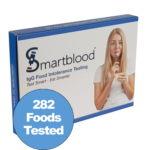
The terms ‘food intolerance’ and ‘food allergy’ are often used interchangeably. While they are commonly mistaken and misunderstood, the two reactions involved are very different.
True food allergies are relatively rare, affecting only around 2% of adults and 6-8% of children. Intolerances are far more common, with around 45% of the UK population thought to be living with a food intolerance.
While food intolerances are increasingly recognised and catered for by restaurants, and more free-from food alternatives are available than ever before, there is still a way to go in helping people understand that food intolerances and allergies are not the same.
Food allergies and intolerances may often be confused but they differ in a variety of ways that make them easy to tell apart. While food intolerances can be incredibly debilitating, they are not the same as allergies which can be life threatening, so it’s important to understand the difference.
The scientific difference between food allergy and intolerance
While the biological processes involved in both food allergies and intolerances might seem similar, with the body reacting in response to a perceived threat, they involve different antibodies that trigger specific reactions.
Food allergies involve an immune response. When a person with an allergy consumes an ingredient it identifies as an allergen, the body overreacts, producing antibodies called immunoglobulin E (IgE). These IgE antibodies travel to cells that release chemicals, causing an allergic reaction. The reaction is usually fairly instant and presents in severe symptoms, like a rash, breathing difficulties or anaphylaxis.
Food intolerances are much less severe. The process is similar, with the body releasing immunoglobulin G (IgG) antibodies, but the reaction time is usually slower and the symptoms, although often uncomfortable and frustrating, are not life-threatening.
Here are some other giveaway signs to help you understand the differences between food intolerance and food allergy.
The age you developed the problem
While a food allergy is usually present from birth, food intolerances can develop at any time during your life.
How quickly you react
When it comes to a food allergy, the reaction usually happens instantly. It can be a little slower, but generally no more than two hours after the trigger food is eaten.
With a food intolerance, the reaction time is usually much more delayed. It can be up to 72 hours before you notice the symptoms of your food intolerance, which is one of the biggest hurdles when it comes to pinpointing the exact cause of the problem. You might be blaming your stomach-ache on your dinner when really, the trigger food was something you ate for breakfast two days ago.
Common symptoms
The symptoms of food allergy appear rapidly and can be very severe. These include:
- Itching
- Breathing trouble
- Dizziness
- Fainting
- Loss of consciousness
- Rapid pulse
- Swelling
- Vomiting or diarrhoea
- Wheezing
While food intolerances can certainly make you feel very unwell, the symptoms are not dangerous. Common symptoms of food intolerance include:
- Arthritis
- Bloating
- Depression
- IBS
- Migraines
- Psoriasis
- Rhinitis
- Tiredness
- Weight issues
How long it lasts
Food allergies are lifelong. Sufferers will always need to avoid the trigger food and must always be mindful of checking ingredients.
Food intolerances, however, can clear after a period of time spent avoiding the trigger food. If you have identified the ingredients in your diet that are causing problems, you can replace your trigger foods with nutritious alternatives until you are again able to tolerate them.
Testing options
Testing options for food intolerance and food allergy are quite different.
If you are concerned that you have a food allergy, it is possible to get tested through the NHS. After a consultation to explore your symptoms, your GP may refer you to an allergy clinic for a test. Options include a skin prick test or a blood test.
Currently, the NHS do not offer a test for food intolerance. There are many private options you can explore but it’s important to do your research. Not all types of food intolerance test will give you a clear and accurate result and there are a lot of options available on the market, such as Vega, kinesiology and hair analysis, which have no proven basis in science.
Taking control of your food intolerances
Hopefully, you now have a clearer understanding of the difference between food allergy and food intolerance. With almost half of the UK population living with a food intolerance, it’s clear that this is a common problem that impacts many of us day-to-day.
If you are experiencing some of the symptoms listed above, you might be wondering whether you too have a food intolerance.
The traditional ‘gold standard’ used to detect food intolerance is an elimination diet. This is a slow process that involves removing one food from your diet at a time, for a few weeks per ingredient, and tracking how you feel. With food intolerance sufferers reacting, on average, to between 4-6 ingredients, it can take a long time before you have a complete picture of your trigger foods. It’s not uncommon for people to stop the elimination diet before all trigger foods have been found, thinking they have cracked the problem after finding just one of the ingredients.
At Smartblood, we offer a comprehensive test to help you take control of your diet quickly. Our home-to-laboratory service, using ELISA plate testing, gives you fast, accurate results that pinpoint exactly which foods you are reacting to. Tests are completed in our accredited laboratory by trained experts, with clear, accurate results delivered to you via email within three days. The test is supported by a 30-minute consultation with our BANT registered Nutritional Therapist to help you understand your results and make safe, sustainable changes to your diet.




